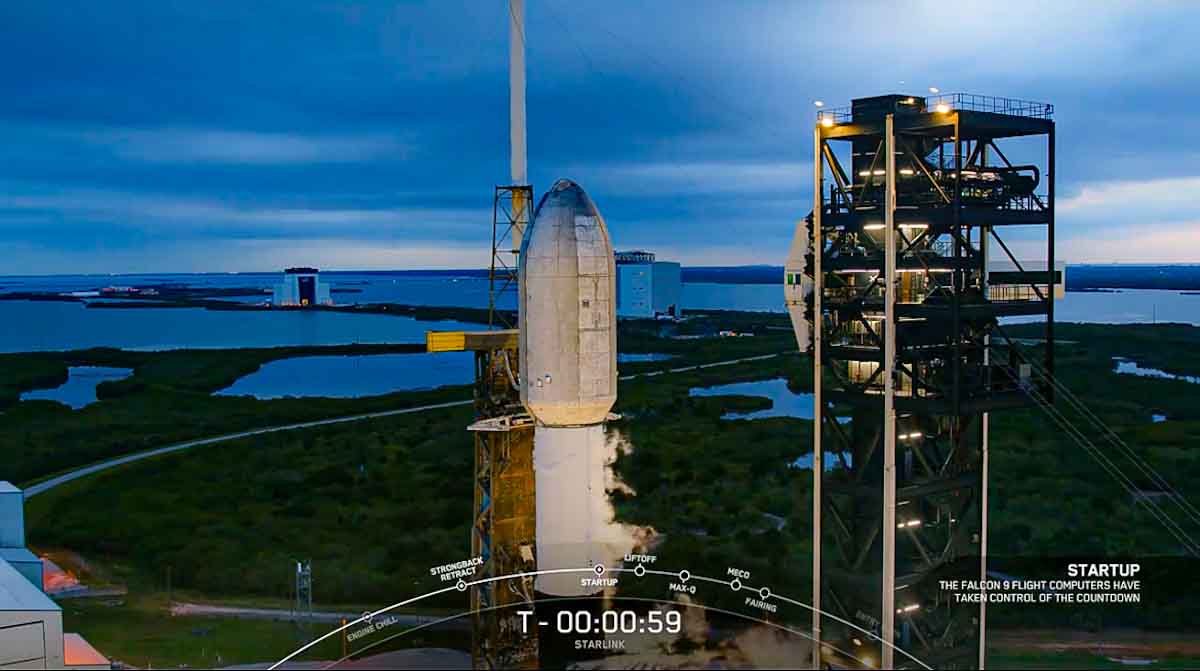Cape Canaveral, FL – SpaceX is preparing for another major Starlink launch as it targets Friday, February 21, for the liftoff of a Falcon 9 rocket carrying 23 Starlink satellites, 13 of which are equipped with Direct-to-Cell capabilities.
The launch is set to take place at Space Launch Complex 40 (SLC-40) at Cape Canaveral Space Force Station in Florida. Liftoff is scheduled for 10:19 a.m. ET, with backup opportunities extending until 10:25 a.m. ET. If necessary, additional launch windows are available on Saturday, February 22, starting at 6:17 a.m. ET.
Watch Falcon 9 launch 23 @Starlink satellites to orbit from Florida, including 13 with Direct to Cell capabilities https://t.co/WCfSh5JIqd
— SpaceX (@SpaceX) February 21, 2025
Mission Overview
This mission is part of SpaceX’s continued effort to expand the Starlink constellation, which aims to provide global broadband coverage, especially in remote and underserved regions.
The addition of Direct-to-Cell technology marks a significant step forward in mobile connectivity, allowing satellite-enabled communication directly to standard mobile phones without requiring specialized hardware.
The first stage booster supporting this mission has an extensive flight history, making its 21st launch. It previously supported notable missions, including CRS-26, OneWeb Launch 16, Intelsat IS-40e, O3b mPOWER, Ovzon 3, Eutelsat 36D, Turksat 6A, Maxar 2, SXM-9, and 11 prior Starlink missions.
SpaceX aims to recover the booster again by landing it on the autonomous droneship A Shortfall of Gravitas, which will be stationed in the Atlantic Ocean.
Expanding Starlink’s Reach with Direct-to-Cell Technology
The inclusion of 13 Direct-to-Cell satellites represents a leap forward in satellite-based communication. This technology is designed to connect users in remote locations where traditional cell networks are unavailable, providing emergency text messaging, calls, and eventually, data services. This initiative could significantly benefit rural communities, maritime users, and disaster response teams worldwide.
SpaceX has been steadily increasing the number of Starlink satellites in orbit, with over 5,500 operational units already deployed. The company envisions a constellation exceeding 40,000 satellites to enhance global connectivity and reduce latency, making internet access seamless even in the most isolated regions.
Live Webcast and Viewing Details
SpaceX will provide a live webcast of the launch approximately five minutes before liftoff. Viewers can watch the event on the company’s official X account (@SpaceX) or through the new X TV app. This accessibility allows space enthusiasts worldwide to follow the mission in real time.
Falcon 9’s Reusability Milestone
One of the hallmarks of SpaceX’s innovation is the reusability of its Falcon 9 rocket. The booster used for this launch has already proven its reliability across 20 missions.
Following liftoff and stage separation, the first stage will attempt a landing on A Shortfall of Gravitas, one of SpaceX’s autonomous droneships stationed in the Atlantic Ocean.
This landing, if successful, will mark another achievement in the company’s efforts to reduce launch costs and improve sustainability in spaceflight.
Future Launch Opportunities
If the launch is delayed due to weather or technical issues, SpaceX has additional launch windows on February 22, starting at 6:17 a.m. ET. Weather conditions and pre-flight checks will determine whether the primary or backup launch opportunities are utilized.
SpaceX’s upcoming Starlink mission is another step in its vision to make space-based internet more accessible to people worldwide. The integration of Direct-to-Cell technology further cements the company’s leadership in satellite communications.
With a highly experienced Falcon 9 booster and a strategic plan for ongoing launches, SpaceX continues to revolutionize the way we connect to the internet from anywhere on Earth. Stay tuned for live coverage and updates as this mission unfolds.
